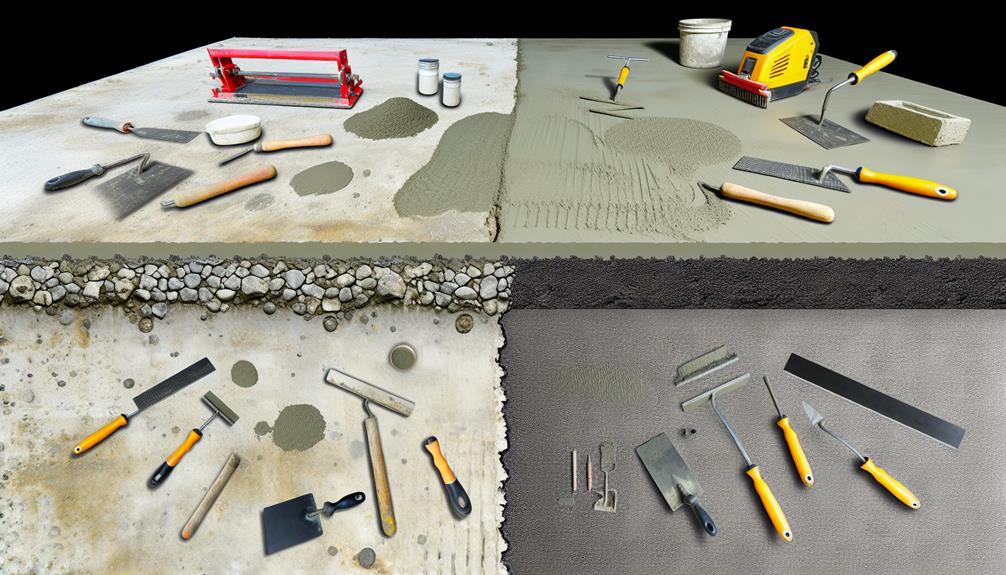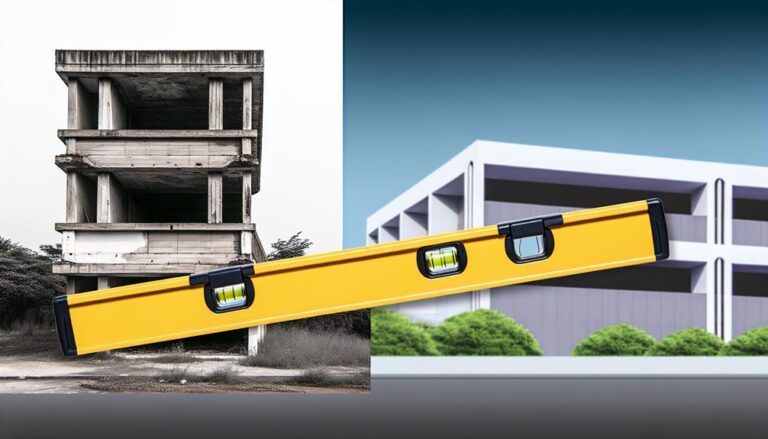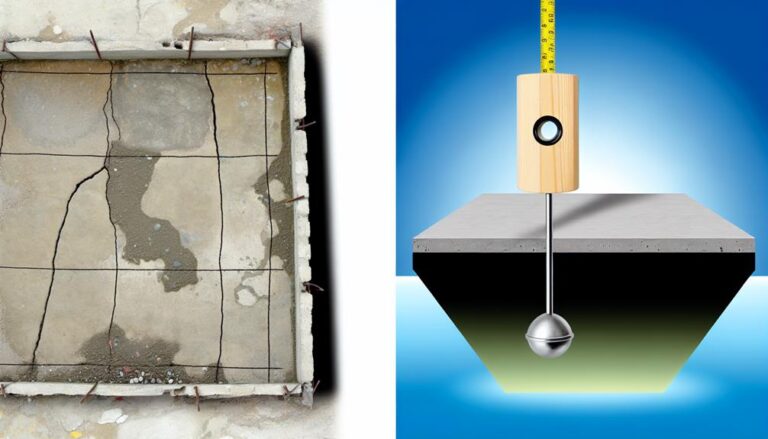Guide to Concrete Leveling: Techniques and Benefits
Concrete leveling, whether through mudjacking, polyurethane foam injection, or slab piling, helps rectify uneven surfaces in a cost-effective, quick, and environmentally friendly way. You'll appreciate improved property appearance and increased safety with less risk of water pooling and structural damage. It's a crucial step in projects, enhancing stability and longevity. Whether you're focusing on residential aesthetics, industrial machinery efficiency, or preventing future costs, concrete leveling plays a vital role. The right technique tailors to your specific situation. Ready to understand more about this economical powerhouse and how it can add value to your property? Let's explore.
Understanding Concrete Leveling Techniques
While you might think concrete leveling is a complex process, it's actually quite straightforward once you understand the various techniques involved. Essentially, it's all about correcting uneven and sunken concrete slabs. You might be wondering, how does this happen? Well, there are a few common methods to get you there.
Mudjacking, also known as slabjacking, is one popular technique. It involves pumping a mixture of water, soil, and cement under the concrete slab to lift it back to its original position. Don't worry, it's not as messy as it sounds!
Then there's polyurethane foam injection. This method involves drilling small holes into the concrete slab and injecting a special foam that expands and lifts the slab. It's faster and less invasive than mudjacking.
There's also a technique called slab piling or piering. Here, steel or concrete piers are driven into the ground to support the concrete slab and lift it.
Each method has its own pros and cons, and the best one for you depends on your specific situation. So, don't be intimidated. Now that you're familiar with these techniques, you're well on your way to understanding concrete leveling.
Benefits of Concrete Leveling
You're probably wondering, 'what's in it for me?' when it comes to concrete leveling. Well, this process comes with a host of benefits that you'll appreciate. For starters, it's cost-effective. Concrete leveling often costs half, or even less, than the price of replacement.
Secondly, it's a quick process. Most jobs can be completed in hours, with the concrete ready to bear weight again just 24 hours later. This minimizes downtime, especially important for business properties.
Lastly, it's environmentally friendly. By repairing the concrete you already have, you're reducing waste that would otherwise end up in a landfill.
| Benefit | Description |
|---|---|
| Cost-Effective | Costs half, or less, than replacement |
| Quick | Most jobs done in hours, ready in 24 hours |
| Environmentally Friendly | Reduces waste in landfills |
Concrete leveling can also increase your property value by improving its appearance and safety. Cracks and uneven surfaces can be trip hazards, so leveling can prevent accidents.
Concrete Leveling in Construction Projects
Having explored the benefits of concrete leveling, let's now examine its role in construction projects.
Concrete leveling is a crucial phase of most construction projects, whether it's a small-scale structure or a high-rise building. It's the process of adjusting the concrete's surface to ensure it's perfectly flat and level. This is essential in construction as it directly affects the stability and longevity of the structure.
Your project's success heavily relies on the quality of the concrete leveling. A poorly leveled concrete can lead to structural issues such as uneven floors, cracks, and even structural instability. It can also cause water pooling, which can lead to further damage.
Various techniques are used in concrete leveling, including mudjacking, grinding, and self-leveling. Each method has its benefits and is best suited for specific situations. Mudjacking, for example, is ideal for filling voids beneath the concrete, while grinding is effective for removing high spots.
In a nutshell, concrete leveling is a fundamental part of construction projects. It ensures the integrity, safety, and longevity of structures. So, it's crucial to understand its importance and make sure it's done correctly. Remember, proper concrete leveling is an investment in the durability of your project.
Residential Applications of Concrete Leveling
In countless homes, concrete leveling plays a vital role in maintaining the structural integrity and aesthetic appeal of various residential features. It's a cost-effective method that corrects uneven concrete surfaces, preventing you from replacing the entire slab. Imagine your driveway or patio looking brand new without the hefty price tag and time-consuming effort of a full replacement.
Concrete leveling isn't just about aesthetics, though. It also ensures safety in your home. Uneven concrete can cause tripping hazards, especially in high-traffic areas like walkways or steps. By leveling the concrete, you eliminate these risks, making your home safer for you and your family.
Moreover, this technique is also beneficial for your home's drainage system. Properly leveled concrete directs water away from your home, preventing foundation damage caused by water pooling.
But how does it work? Well, concrete leveling involves injecting a mixture beneath the concrete slab, causing it to rise until it's level. This method is quicker and less intrusive than traditional methods, ensuring minimal disruption to your everyday life. So, when it comes to maintaining your home's appeal and safety, don't overlook the importance of concrete leveling.
Industrial Use of Concrete Leveling Techniques
Just as concrete leveling proves beneficial in residential settings, it's also a crucial technique utilized in various industrial applications. Warehouses, factories, airports – these are just a few places where you'll find concrete leveling at work.
Imagine a factory floor that's uneven, causing machinery to operate less efficiently. Or a warehouse where uneven flooring hinders the smooth movement of forklifts. In these scenarios, concrete leveling isn't merely a cosmetic improvement; it's a necessity for maintaining productivity.
Concrete leveling techniques, like mudjacking and polyurethane foam injection, are often used to correct these issues. Mudjacking involves pumping a mixture of water, soil, and cement under the concrete slab to lift it. On the other hand, polyurethane foam injection fills the gaps underneath the concrete, expanding to lift the slab to its correct level.
These techniques offer a cost-effective solution compared to completely replacing the concrete. Plus, they cause minimal disruption to operations, as the areas can be used shortly after the procedure.
Enhancing Safety Through Concrete Leveling
Often overlooked, concrete leveling significantly enhances safety by preventing trip hazards and potential damage to vehicles or machinery. It's not just about aesthetics; it's a critical component in maintaining a safe environment.
Imagine walking in a parking lot, warehouse, or even your home's patio and tripping over an uneven concrete surface. You wouldn't want that, would you? Uneven concrete can lead to slip-and-fall accidents, which can cause serious injuries. By leveling the concrete, you eliminate these potential hazards, making the area safer for everyone.
Moreover, uneven concrete can wreak havoc on vehicles or machinery. It can lead to premature tire wear, suspension damage, and other costly issues. With concrete leveling, you're ensuring smoother operations, reducing maintenance, and avoiding unnecessary expenses.
In industries where heavy machinery is used, like manufacturing or construction, concrete leveling becomes even more crucial. Uneven surfaces can damage machinery, disrupt production, and risk worker safety.
Cost-effectiveness of Concrete Leveling Techniques
Concrete leveling techniques aren't just about safety; they're also a savvy financial move for property owners. You might think that leveling your concrete is an unnecessary expense, but in the long run, it's a cost-effective solution.
Let's break it down. When concrete settles, it becomes uneven and poses a tripping hazard. The damages caused by accidents from this hazard can cost you significantly in terms of medical expenses or potential lawsuits. By leveling the concrete, you're proactively reducing these risks and their associated costs.
Moreover, unlevelled concrete often results in water pooling, leading to structural damage over time. This damage could be costly to repair, and in severe cases, you may need to replace the entire structure. With concrete leveling, you're preventing these issues from developing in the first place, saving you from expensive repairs or replacements.
Lastly, leveled concrete enhances the curb appeal of your property, potentially increasing its value. So, while the upfront cost of concrete leveling might seem high, it's an investment that can save you money, prevent future costs, and even add value to your property. It's clear that concrete leveling techniques aren't just practical, but also economically wise.
Frequently Asked Questions
What Are the Environmental Impacts of Concrete Leveling?
You're asking about the environmental impacts of concrete leveling.
Well, it's generally a greener option than replacing concrete. It uses less material and energy, so it's less taxing on the environment. Additionally, it keeps waste concrete out of landfills.
However, the process can disturb local ecosystems if not managed carefully. It's a balance, really, but overall, concrete leveling tends to be more environmentally friendly than other methods.
Can Concrete Leveling Be a DIY Project or Does It Require Professional Assistance?
Sure, you can attempt concrete leveling as a DIY project. Grab your magic wand, sprinkle some fairy dust, and voila! But, it's not that simple.
It's a labor-intensive process that requires specialized equipment and expertise. One wrong move and you're looking at a lumpy, uneven surface.
Are There Any Specific Maintenance Practices Required After Concrete Leveling?
Sure, there're specific maintenance practices after concrete leveling.
You should avoid heavy traffic on the leveled surface for a few days. It's also important to keep it clean and free of debris.
Over time, check for cracks or unevenness that might occur. If you see any issues, it's best to consult with a professional.
How Long Does a Concrete Leveling Job Typically Last Before Another Leveling Is Needed?
You're probably wondering how long your concrete leveling job will last before it needs another touch-up. It actually depends on several factors like the quality of work, weather conditions, and soil movement.
However, under ideal conditions, you can expect it to last for many years, even up to a decade. Bear in mind, though, regular maintenance can extend its lifespan. It's always best to consult with a professional for specifics related to your case.
Can Concrete Leveling Be Used in Areas With Extreme Weather Conditions?
Yes, you can use concrete leveling in areas with extreme weather conditions. It's designed to withstand temperature changes and harsh elements.
However, it's vital to consider the ground's freeze-thaw cycle in cold climates, as it may affect the leveling process. Additionally, ensure the mixture used is suitable for your area's weather conditions.
Conclusion
So, you've seen how concrete leveling can enhance safety, cut costs, and add value to your properties. It's no wonder that according to the Portland Cement Association, 75% of all concrete is used in construction.
With the right techniques, you can make the most of this material. Remember, a leveled surface isn't just about aesthetics — it's about maximizing the benefits of concrete in our everyday lives.






